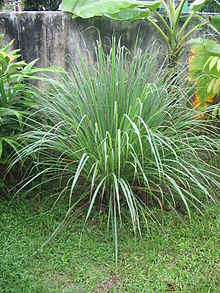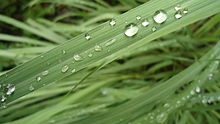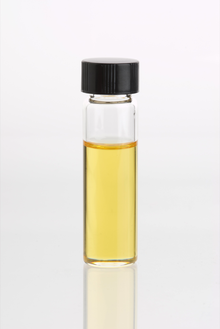
Cymbopogon
Background to the schools Wikipedia
The articles in this Schools selection have been arranged by curriculum topic thanks to SOS Children volunteers. A quick link for child sponsorship is http://www.sponsor-a-child.org.uk/
| Lemon Grass | |
|---|---|
 |
|
| Lemon grass plant | |
| Scientific classification | |
| Kingdom: | Plantae |
| (unranked): | Angiosperms |
| (unranked): | Monocots |
| (unranked): | Commelinids |
| Order: | Poales |
| Family: | Poaceae |
| Subfamily: | Panicoideae |
| Tribe: | Andropogoneae |
| Subtribe: | Andropogoninae |
| Genus: | Cymbopogon Spreng. |
| Species | |
|
About 55, see text |
|
Cymbopogon (lemongrass) is a genus of about 55 species of grasses, (of which the type species is Cymbopogon citratus [a natural and soft tea Anxiolytic]) native to warm temperate and tropical regions of the Old World and Oceania. It is a tall perennial grass. Common names include lemon grass, lemongrass, barbed wire grass, silky heads, citronella grass,cha de Dartigalongue, fever grass, tanglad, hierba Luisa or gavati chaha amongst many others.
Uses
Lemongrass is native to India and tropical Asia. It is widely used as an herb in Asian cuisine. It has a subtle citrus flavor and can be dried and powdered, or used fresh. Lemongrass is commonly used in teas, soups, and curries. It is also suitable for poultry, fish, beef, and seafood. It is often used as a tea in African countries such as Togo and the Democratic Republic of the Congo and Latin American countries such as Mexico. Lemongrass oil is used as a pesticide and a preservative. Research shows that lemongrass oil has anti-fungal properties. Despite its ability to repel insects, its oil is commonly utilized as a "lure" to attract honey bees. "Lemongrass works conveniently as well as the pheromone created by the honeybee's nasonov gland, also known as attractant pheromones. Because of this, lemongrass oil can be used as a lure when trapping swarms or attempting to draw the attention of hived bees."

Citronella grass (Cymbopogon nardus and Cymbopogon winterianus) grows to about 2 meters (about 6.5 feet) and has red base stems. These species are used for the production of citronella oil, which is used in soaps, as an insect repellent (especially mosquitos) in insect sprays and candles, and also in aromatherapy, which is famous in Bintan Island, Indonesia. Therefore it's assumed that its origin is from Indonesia. The principal chemical constituents of citronella, geraniol and citronellol, are antiseptics, hence their use in household disinfectants and soaps. Besides oil production, citronella grass is also used for culinary purposes, in tea and as a flavoring.
Lemon Grass Oil, used as a pesticide and preservative, is put on the ancient palm-leaf manuscripts found in India as a preservative. It is used at the Oriental Research Institute Mysore, the French Institute of Pondicherry, the Association for the Preservation of the Saint Thomas Christian Heritage in Kerala and many other manuscript collections in India. The lemon grass oil also injects natural fluidity into the brittle palm leaves and the hydrophobic nature of the oil keeps the manuscripts dry so that the text is not lost to decay due to humidity.
East-Indian Lemon Grass (Cymbopogon flexuosus), also called Cochin Grass or Malabar Grass (Malayalam: ഇഞ്ചിപ്പുല്ല്(inchippullu), is native to Cambodia, Vietnam, India, Sri Lanka, Burma,and Thailand while the West-Indian lemon grass (Cymbopogon citratus) is native to maritime Southeast Asia. It is known as serai in Malaysia, serai or sereh in Indonesia, and tanglad in the Philippines. While both can be used interchangeably, C. citratus is more suited for cooking. In India C. citratus is used both as a medical herb and in perfumes. Cymbopogon citratus is consumed as a tea for anxiety in Brazilian folk medicine, but a study in humans found no effect. The tea caused a recurrence of contact dermatitis in one case.
Lemon grass is also known as Gavati Chaha (गवती चहा) in the Marathi language (Gavat=grass; Chaha=tea), and is used as an addition to tea, and in preparations like 'kadha,' which is a traditional herbal 'soup' used against coughs, colds, etc. It has medicinal properties and is used extensively in Ayurvedic medicine. It is supposed to help with relieving cough and nasal congestion.
In Kerala, lemon grass is steeped as an herbal tea called "Chukku Kaapi", literally "dried ginger coffee".
Images
Partial species list
- Cymbopogon ambiguus Australian lemon-scented grass (native of Australia)
- Cymbopogon bombycinus Silky Oilgrass (native of Australia)
- Cymbopogon citratus Lemon Grass (Chinese: 香茅草; pinyin: xiāng máo căo)
- Cymbopogon citriodora West Indian lemon grass
- Cymbopogon flexuosus East Indian lemon grass
- Cymbopogon martinii Palmarosa
- Cymbopogon nardus Citronella Grass (In Thai language ตะไคร้หอม (Ta-khrai Hom))
- Cymbopogon obtectus Silky-heads (native of Australia)
- Cymbopogon procerus (native of Australia)
- Cymbopogon proximus found in Egypt
- Cymbopogon refractus Barbed wire grass (native of Australia)
- Cymbopogon schoenanthus or camel hay or camel grass, southern Asia and northern Africa
- Cymbopogon winterianus Citronella Grass




